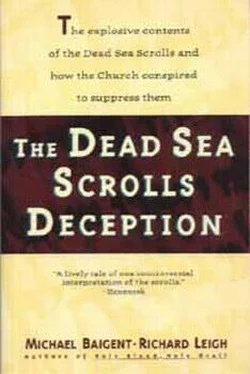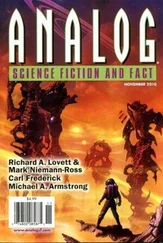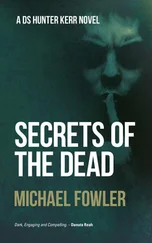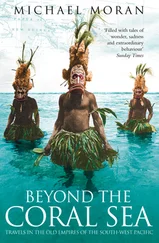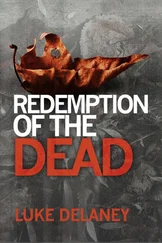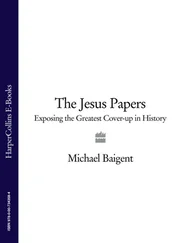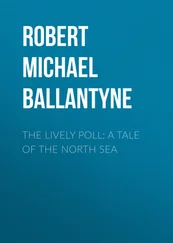Cecil Roth was perhaps the most prominent Jewish historian of his era. After serving with the British Army during the First World War, he had obtained his doctorate from Merton College, Oxford, as an historian. For some years, he was Reader in Jewish Studies at Oxford — the post now occupied by Geza Vermes. He was a prolific writer, with more than six hundred publications to his credit. He was also editor-in-chief of the Encyclopaedia judaica. He commanded enormous respect in the academic world, and was recognised especially for his expertise in Judaic history.
Godfrey Driver was a figure of comparable academic stature. He, too, had served with the British Army during the First World War, seeing action particularly in the Middle East. He, too, taught at Oxford, at Magdalen College, becoming, in 1938, Professor of Semitic Philology. Until 1960, he also did three stints as Professor of Hebrew. He was joint director of the team which translated the Old Testament for the New English Bible. As we have noted, he was John Allegro’s mentor, and recommended Allegro for the international team.
From the very first discoveries of the Dead Sea Scrolls, Professor Driver had advocated caution about the early, pre-Christian dates ascribed to them. In a letter to The Times on 23 August 1949, he warned that the pre-Christian date ascribed to the Qumran scrolls ‘seems likely to win general acceptance before being subjected to critical examination’. 1In the same letter, he stated: ‘The external evidence… for a pre-Christian date is extremely precarious, while all the internal evidence seems against it. ‘ 2Driver stressed the risks of attributing too much accuracy to what he called ‘external evidence’ — to archaeology and palaeography. He advocated, rather, a scrutiny of the ‘internal evidence’ — the content of the scrolls themselves. On the basis of such evidence, he was eventually to conclude that the scrolls dated from the 1st century of the Christian era.
In the meantime, Cecil Roth had been conducting his own research and, in 1958, published the results in a work entitled The Historical Background of the Dead Sea Scrolls. The historical background, he argued, was not pre-Christian, but, on the contrary, dated from the time of the revolt in Judaea, between ad 66 and 74. Like Driver, Roth insisted that the texts of the scrolls themselves were a more accurate guide than archaeology or palaeography. Availing himself of this guide, he developed a number of points that not only ran counter to the international team’s consensus, but must also have outraged the Catholics among them. Citing textual references in one of the scrolls, for instance, he demonstrated that the ‘invaders’ regarded as adversaries by the Qumran community could only be Romans — and, further, could only be Romans of the Empire, of imperial rather than republican times. He also demonstrated that the militant nationalism and messianic fervour in many of the scrolls had less in common with traditional images of the Essenes than with the Zealots described by Josephus. He acknowledged that the original community at Qumran might indeed have been established by Essenes of the traditional kind, but if so, he contended, they would have vacated the site when it was destroyed in 37 bc. Those who occupied it subsequently, after 4 bc, and who deposited the scrolls, would not have been Essenes at all, but Zealots. Pursuing his argument a step further, he then endeavoured to establish links between the Qumran community and the fierce defenders of Masada thirty miles to the south.
Such assertions, needless to say, provoked indignant criticism from Father de Vaux’s team. One of de Vaux’s associates, Jean Carmignac, in reviewing Roth’s book, complained that Roth ‘does not miss any occasion to closely link Masada and Qumran, but this is another weakness of his thesis’. 3Even when, eight years later, Yigael Yadin, in his excavations at Masada, found scrolls identical to some of those discovered at Qumran, the international team refused to consider Roth’s thesis. Quite clearly, some sort of connection had to exist between Qumran and Masada, yet the team, their logic now creaking painfully at the seams, insisted only one explanation was possible — ‘some’ of the Essenes from Qumran must have deserted their own community and gone to the defence of Masada, bringing their sacred texts with them!
So far as Masada was concerned, Roth was, then, to be vindicated by Yadin’s excavations. But he was also quite capable of fighting his own battles. In an article published in 1959, he focused particularly on de Vaux’s assertion, based on supposed ‘archaeological evidence’, that the scrolls could not have been deposited any later than the summer of ad 68, when Qumran was ‘taken by the 10th Legion’. 4Roth demonstrated conclusively that the 10th Legion, in the summer of AD 68, was nowhere near Qumran. 5
Roth’s arguments may have infuriated de Vaux’s international team, but they were shared by his colleague Godfrey Driver. The two worked closely together, and in 1965 Driver published his massive and detailed opus on the Qumran material, The Judaean Scrolls. According to Driver, ‘arguments to establish a pre-Christian date of the Scrolls are fundamentally unsound’. The sole reasons for establishing such a date were, he pointed out, palaeographical, ‘and these cannot stand alone’. 6Driver agreed with Roth that the scrolls referred to the period of the revolt in Judaea, between ad 66 and 74, and were thus ‘more or less’ contemporary with the New Testament. He also concurred with Roth that the Qumran community must have consisted of Zealots, not traditional Essenes. He calculated that the scrolls could have been deposited at Qumran any time between then and the end of the second revolt in Judaea, the rebellion of Simeon bar Kochba between ad 132 and 135. He was scathing about the scholarship of the international team, as exemplified especially by de Vaux.
Roth and Driver were both famous, acknowledged, ‘heavyweights’ in their respective historical fields, who could not be ignored or cavalierly dismissed. Their prestige and their learning could not be impugned or discredited. Neither could they be isolated. And they were too skilled in academic controversy to put their own necks into a noose, as Allegro had done. They were, however, vulnerable to the kind of patronising condescension that de Vaux and the international team, closing ranks in their consensus, proceeded to adopt. Roth and Driver, august though they might be, were portrayed as out of their element in the field of Qumran scholarship. Thus, de Vaux, reviewing Driver’s book in 1967, wrote, ‘It is a sad thing to find here once more this conflict of method and mentality between the textual critic and the archaeologist, the man at his desk and the man in the field. ‘ 7Not, of course, that de Vaux spent so very much time ‘in the field’ himself. As we have seen, he and most others on the international team were content to remain ensconced in their ‘Scrollery’, leaving the bulk of the fieldwork to the Bedouin. But the ‘Scrollery’, it might be argued, was at least closer to Qumran than was Oxford. Moreover, de Vaux and his team could claim first-hand familiarity with the entire corpus of Qumran texts, which Roth and Driver, denied access to those texts, could not. And while Roth and Driver had questioned the international team’s historical method, they had not actually confronted its excessive reliance on archaeology and palaeography.
Archaeology and palaeography appeared to be the team’s strengths, allowing de Vaux to conclude his review of The Judaean Scrolls by stating, confidently and definitively, that ‘Driver’s theory… is impossible’. 8He could also, by invoking archaeology and palaeography, dazzle other figures in the field and effectively hijack their support. Thus Professor Albright was persuaded to weigh in against Driver, whose thesis, Albright declared, ‘has failed completely’. Its failure, Albright went on, derived from ‘an obvious scepticism with regard to the methodology of archaeologists, numismatists, and palaeographers. Of course, he [Driver] had the bad luck to run into head-on collision with one of the most brilliant scholars of our day — Roland de Vaux…’ 9
Читать дальше
